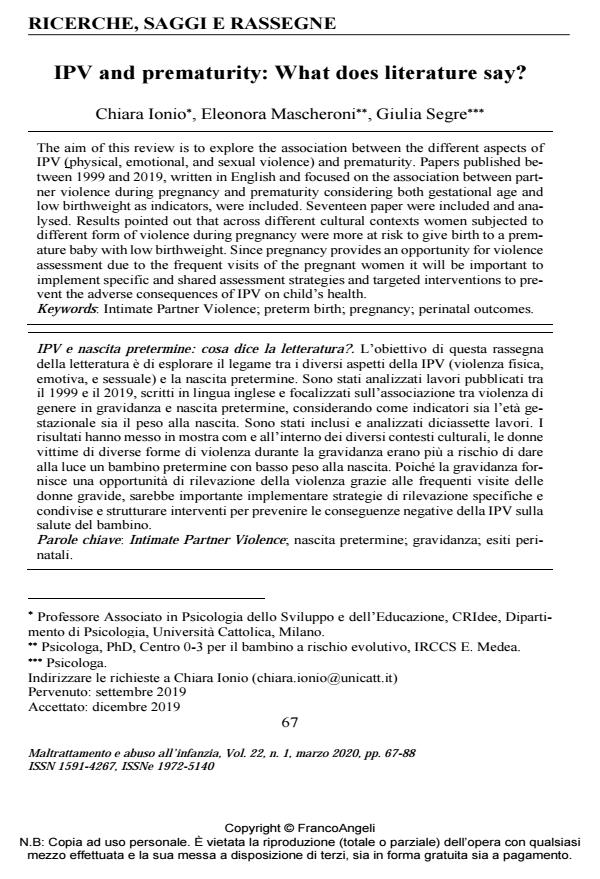IPV and prematurity: What does literature say?
Titolo Rivista MALTRATTAMENTO E ABUSO ALL’INFANZIA
Autori/Curatori Chiara Ionio, Eleonora Mascheroni, Giulia Segre
Anno di pubblicazione 2020 Fascicolo 2020/1
Lingua Inglese Numero pagine 22 P. 67-88 Dimensione file 243 KB
DOI 10.3280/MAL2020-001006
Il DOI è il codice a barre della proprietà intellettuale: per saperne di più
clicca qui
Qui sotto puoi vedere in anteprima la prima pagina di questo articolo.
Se questo articolo ti interessa, lo puoi acquistare (e scaricare in formato pdf) seguendo le facili indicazioni per acquistare il download credit. Acquista Download Credits per scaricare questo Articolo in formato PDF

FrancoAngeli è membro della Publishers International Linking Association, Inc (PILA)associazione indipendente e non profit per facilitare (attraverso i servizi tecnologici implementati da CrossRef.org) l’accesso degli studiosi ai contenuti digitali nelle pubblicazioni professionali e scientifiche
The aim of this review is to explore the association between the different aspects of IPV (physical, emotional, and sexual violence) and prematurity. Papers published between 1999 and 2019, written in English and focused on the association between partner violence during pregnancy and prematurity considering both gestational age and low birthweight as indicators, were included. Seventeen paper were included and analysed. Results pointed out that across different cultural contexts women subjected to different form of violence during pregnancy were more at risk to give birth to a premature baby with low birthweight. Since pregnancy provides an opportunity for violence assessment due to the frequent visits of the pregnant women it will be important to implement specific and shared assessment strategies and targeted interventions to prevent the adverse consequences of IPV on child’s health.
L’obiettivo di questa rassegna della letteratura è di esplorare il legame tra i diversi aspetti della IPV (violenza fisica, emotiva, e sessuale) e la nascita pretermine. Sono stati analizzati lavori pubblicati tra il 1999 e il 2019, scritti in lingua inglese e focalizzati sull’associazione tra violenza di genere in gravidanza e nascita pretermine, consideran-do come indicatori sia l’età gestazionale sia il peso alla nascita. Sono stati inclusi e ana-lizzati diciassette lavori. I risultati hanno messo in mostra com e all’interno dei diversi contesti culturali, le donne vittime di diverse forme di violenza durante la gravidanza erano più a rischio di dare alla luce un bambino pretermine con basso peso alla nascita. Poiché la gravidanza fornisce una opportunità di rilevazione della violenza grazie alle frequenti visite delle donne gravide, sarebbe importante implementare strategie di rile-vazione specifiche e condivise e strutturare interventi per prevenire le conseguenze ne-gative della IPV sulla salute del bambino.
Parole chiave:Intimate Partner Violence; nascita pretermine; gravidanza; esiti perinatali.
Chiara Ionio, Eleonora Mascheroni, Giulia Segre, IPV and prematurity: What does literature say? in "MALTRATTAMENTO E ABUSO ALL’INFANZIA" 1/2020, pp 67-88, DOI: 10.3280/MAL2020-001006